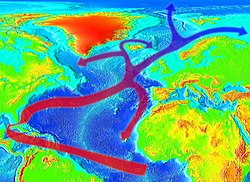Barents Sea Opening
 From Wikipedia - Reading time: 4 min
From Wikipedia - Reading time: 4 min

The Barents Sea Opening (BSO) is an oceanographic term for the Western Barents Sea. It is a sea area between Bear Island in the south of Svalbard and the northern extremity of Norway through which a water mass of Atlantic origin flows into the Arctic Ocean.[1] The inflow of relative warm water into the Arctic Ocean occurs not only through the Barents Sea Opening, but also through Fram Strait which is much deeper. The internal energy entering the colder waters has an influence on the atmosphere and the sea ice above and therefore possibly on the global climate.
Oceanographic measurements
[edit]The Norwegian Polar Institute performs about six hydrographic survey per year across the Barents Sea Opening from 71°35′N 20°00′E / 71.58°N 20°E to 73°35′N 20°00′E / 73.58°N 20°E since 1977.[2] A set of oceanographic current meters captures the seasonal cycle of the inflow since 1997. Roughly every 30 nm two instruments are deployed, one at 50 m depth, and another 15 m above the sea floor.
References
[edit]- ^ Årthun, M.; Eldevik, T.; Smedsrud, L. H.; Skagseth, Ø.; Ingvaldsen, R. B. (1 July 2012). "Quantifying the Influence of Atlantic Heat on Barents Sea Ice Variability and Retreat*". Journal of Climate. 25 (13): 4736–4743. Bibcode:2012JCli...25.4736A. doi:10.1175/JCLI-D-11-00466.1. S2CID 129321974.
- ^ Ingvaldsen, Randi B. (1 January 2004). "Velocity field of the western entrance to the Barents Sea". Journal of Geophysical Research. 109 (C3). Bibcode:2004JGRC..109.3021I. doi:10.1029/2003JC001811. hdl:1956/375.
72°0′N 20°0′E / 72.000°N 20.000°E
 KSF
KSF